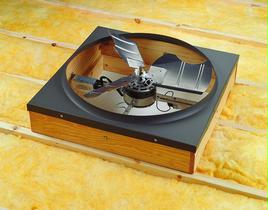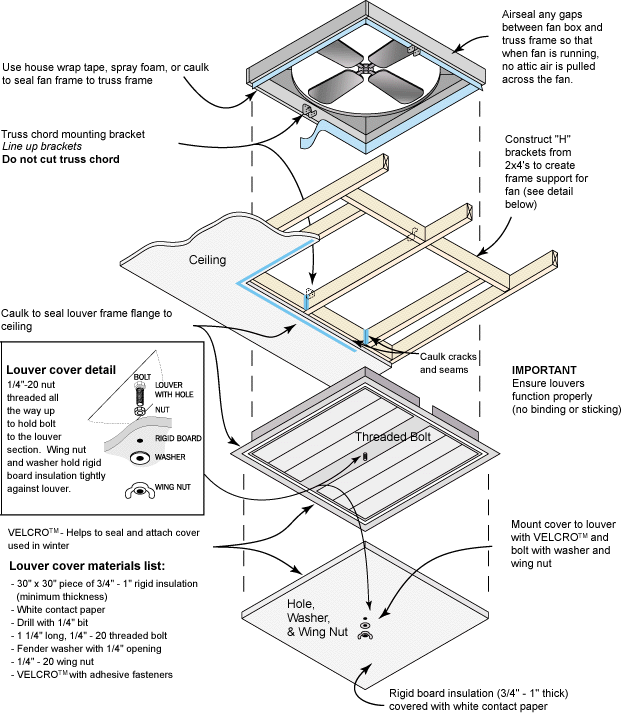whole-house fan

Whole house fan.

Whole house fan installation.
A whole-house fan is a mechanical/electrical device used to pull air out of an interior space; it is usually located in the highest location of a building, in the ceiling, and venting to the attic or directly to the outside. A whole house fan is a simple and inexpensive method of cooling a house. The fan draws cool outdoor air inside through open windows and exhausts hot indoor air through the attic to the outside. Running a whole house fan whenever outdoor temperatures are lower than indoor temperatures will cool a house. In summer, the air inside a home is heated during the hot part of the day. During the morning, late evening, and night, the outside air is often cooler and can be used to replace the inside air. Operating the whole house fan at these times will cool interior materials. As daytime temperatures rise, the whole house fan can be turned off. The cool materials (along with ceiling or circulating fans, which create an additional cooling effect) will help keep the interior more comfortable.
A whole house fan can be used as the sole means of cooling or to reduce the need for air conditioning. If both methods of cooling are present, seasonal use of the whole house fan (during spring and fall) may yield the optimum combination of comfort and cost.
Installation
Caulk all penetrations between the attic and living space, such as electrical boxes for ceiling light fixtures, loose attic hatches, large cutouts for plumbing vents, exposed beams, and recessed lights. A whole house fan creates a positive pressure in the attic; it is important that air from the attic is not forced back into the living space through cracks and gaps.
A guideline for sufficient attic vent area is one square foot of net-free vent area per 750 cfm of fan airflow. Continuous ridge and soffit vents are usually more than adequate. Vents with insect screens may have a net-free area equivalent to one-half of the total open area, depending upon the size of the holes in the screen area. Insulation should be installed directly against the fan box frame. Blown-in insulation may require the sides of the fan box to be raised (with baffles) to prevent interference.
USE "H" BRACKETS TO PROVIDE PROPER SUPPORT. When installing a whole house fan, be sure to provide proper support and seal the unit into the rough opening in the ceiling. Never cut a truss chord; wooden "H" brackets installed between the trusses create a framed box to raise the fan above the truss system. The louvers must be able to open and close freely and care must be taken to prevent binding or misalignment. A fan with a 34" base (30" blade) will work with the dimensions shown in the diagram at left.
BUILD AN ATTIC-SIDE BOX COVER. A typical whole house fan has a 30" diameter blade with a sheet metal cowling of 31" to allow for blade clearance. An attic-side box cover may be constructed from a 4' x 4' piece of 1" rigid fiberglass duct board. The box will be 33" square with 1" thick walls (inside dimension of 31" x 31"). It will be 61/2" deep. Adjust dimensions to actual fan size. Attic-side box cover materials list: (1) 48" x 48" piece of 1" fiberglass duct board; (2) Silver duct tape or house wrap tape; (3) Tools: Measuring tape, straight edge, utility knife, permanent marker to label box; (4) Note: Wear gloves and eye protection when working with duct board.
AVOID BACKDRAFTS. Care should be taken to avoid backdrafting combustion appliances that are installed in the conditioned space. It is strongly recommended that combustion appliances NOT be installed in such a manner that they use room air for combustion. A whole house fan is capable of pulling large quantities of air from the home and, particularly if not enough windows are open, may easily backdraft a water heater located inside a louvered closet door.
Selecting a whole house fan
FAN SPEED. A two-speed fan permits the entire house to be ventilated quickly on high speed (such as when the occupants first arrive at home) and then provides gentle air circulation at the lower, quieter speed. A variable speed unit offers more flexibility in selecting the desired air movement.
CONTROL OPTIONS. Control may be a simple on/off pull or wall switch, a multi-speed rotary wall switch, or a timer that automatically shuts off the fan at pre-selected time intervals.
LOUVERS. Dampers or louvers typically operate automatically whenever the fan is on. Motorized dampers are available but are not necessary if the louvers are correctly installed and maintained.
MOTOR MOUNTS AND NOISE. A direct drive unit has its fan blades attached directly to the motor shaft. This type of unit is usually less expensive to buy and operates at a higher speed than its belt-driven counterpart. A belt-driven unit typically features a motor driving a slowermoving, larger-diameter fan with four or more blades. It may be quieter, but will require maintenance of the pulley and belt.
Sizing a whole house fan
Determining the amount of airflow in cubic feet per minute (cfm) that the whole house fan should provide involves a simple calculation. Multiply the total gross square footage of the house (include upstairs area) by the ceiling height (typically 8 feet). Select a fan that delivers between one-half to one time that amount of cfm at 0.1" static pressure. For example, a 25' x 40' one-story home is 1,000 square feet and would need an 8 x 1,000 x 1/2 = 4,000 cfm fan or better. A two-speed unit that delivers 4,500 cfm at the high setting (240 watts) and 3,200 cfm at low (120 watts) should be adequate.
